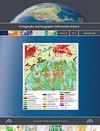从图像到地图和可视化的色彩自适应转移
IF 2.4
3区 地球科学
Q1 GEOGRAPHY
Cartography and Geographic Information Science
Pub Date : 2021-11-10
DOI:10.1080/15230406.2021.1982009
引用次数: 3
摘要
因为在地图和可视化设计中,从零开始制作有吸引力和有效的颜色是一个非常努力和耗时的过程,因此将灵感来源的颜色转移到地图和可视化中对于新手和专家来说都是一种很有前途的技术。到目前为止,现有的图像到图像的颜色转移方法存在歧义和不一致性;没有可用的计算方法将颜色从任意图像转移到矢量地图。为了填补这一空白,我们提出了一种将任意图像的颜色转移到矢量图的计算方法。首先,我们用显著性度量将参考图像分类到不同的区域。其次,我们量化了地图中颜色的沟通质量和美感;然后,我们将颜色转移问题转化为一个双目标、多约束的优化问题。我们还提出了一种解决方法,可以创建一系列最优的颜色建议,并产生一个沟通质量-美学折衷方案。我们将我们的方法与基于两张样本地图和六张参考图像的图像对图像方法进行了比较。结果表明,该方法对尺度、主题和区域的映射具有较好的适应性。评价结果也初步证明了该方法能达到较好的交际质量和交际和谐。本文章由计算机程序翻译,如有差异,请以英文原文为准。
Adaptive transfer of color from images to maps and visualizations
ABSTRACT Because crafting attractive and effective colors from scratch is a high-effort and time-consuming process in map and visualization design, transferring color from an inspiration source to maps and visualizations is a promising technique for both novices and experts. To date, existing image-to-image color transfer methods suffer from ambiguities and inconsistencies; no computational approach is available to transfer color from arbitrary images to vector maps. To fill this gap, we propose a computational method that transfers color from arbitrary images to a vector map. First, we classify reference images into regions with measures of saliency. Second, we quantify the communicative quality and esthetics of colors in maps; we then transform the problem of color transfer into a dual-objective, multiple-constraint optimization problem. We also present a solution method that can create a series of optimal color suggestions and generate a communicative quality-esthetic compromise solution. We compare our method with an image-to-image method based on two sample maps and six reference images. The results indicate that our method is adaptive to mapping scales, themes, and regions. The evaluation also provides preliminary evidence that our method can achieve better communicative quality and harmony.
求助全文
通过发布文献求助,成功后即可免费获取论文全文。
去求助
来源期刊
CiteScore
5.20
自引率
20.00%
发文量
23
期刊介绍:
Cartography and Geographic Information Science (CaGIS) is the official publication of the Cartography and Geographic Information Society (CaGIS), a member organization of the American Congress on Surveying and Mapping (ACSM). The Cartography and Geographic Information Society supports research, education, and practices that improve the understanding, creation, analysis, and use of maps and geographic information. The society serves as a forum for the exchange of original concepts, techniques, approaches, and experiences by those who design, implement, and use geospatial technologies through the publication of authoritative articles and international papers.

 求助内容:
求助内容: 应助结果提醒方式:
应助结果提醒方式:


